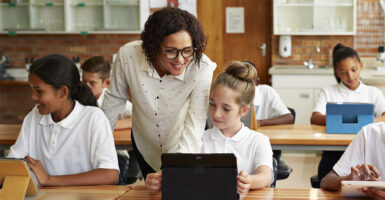New research estimates that some students’ grades will never catch back up after falling during the pandemic. Recently, some in the mainstream media worried that the federal taxpayer money that lawmakers sent to K-12 schools during COVID-19 may not be enough to help schools turn things around.
But public schools—also known as “assigned” schools—had money before the pandemic, and achievement gaps have persisted for decades among students from different economic backgrounds, long before COVID-19. Public education’s slow-motion attempts at meaningful improvement whilst holding checks from taxpayers have parents looking for alternatives.
Small ones.
“I thought schools today must have everything that I had, plus be 40 years better, only to find out that things had gone, if anything, backwards,” said Kathryn Kelly, one of the growing number of entrepreneurs behind microschools, small private schools that offer flexible schedules to students.
A parent herself, Kelly started her school in Nevada years before the pandemic because her adopted sons were “really floundering in school” and needed help. Today, her school, called I-School, is attracting families from all walks of life who have tired of the radical political orthodoxy inside many public school districts along with teachers union campaigns for more taxpayer spending.
Kelly is doing the opposite of what many public systems have tried. Instead of building new facilities and updating classroom technology, Kelly’s school in Carson City is situated in a building built in 1879 that is listed on the National Register of Historic Places.
She explains that the building, like her school’s focus on classic books and a traditional, liberal arts education, is meant to “give kids some magic” as they are surrounded by “history and character.”
“The bar has been set so low” at assigned schools, Kelly said in an interview. She explains that her teachers want to get students “engaged and curious and interactive instead of meekly accepting what is being handed to them.”
Kelly’s program also has an online option, and the combination of in-person and online teaching has reached a variety of students over the last 14 years. “We have full-time kids, have hybrid kids, we have kids that are part-time in the public school, part-time home-schooled. We try to be the school that I wanted when I started out, and that is very flexible for parent needs,” Kelly says.
And it’s working. Kelly explains that I-School has helped a child with cystic fibrosis remain in school while waiting for a lung transplant. Another student is one of the top-ranked high school wrestlers in Alabama who will be attending Columbia University.
Parent interest in microschools surged during and after the pandemic. Families discovered that these schools were not only flexible but could allow parents to remain involved in their children’s education through part-time and other hybrid school schedules.
Nationwide, microschool enrollment growth has been steady, but the schools are designed to be small, which means these modest operations are one part of a growing catalog of K-12 opportunities outside of assigned public schools. Combining her online school and physical location and her new faith-based Hope Academy, Kelly has 40 students enrolled.
Some state lawmakers are making it possible for more families to take advantage of small learning settings like Kelly’s, along with classical private schools, private schools focused on STEM, and more. Policymakers in nine states have adopted the school choice options of either private school scholarships (i.e., private school vouchers) or education savings accounts for which all students in those states are eligible to apply.
This year, Tennessee lawmakers are considering a proposal that would make their state the 10th to adopt such options. In some states, such as North Carolina, parents can use an education savings account to pay tuition at microschools similar to I-School in Nevada. With an education savings account, the state deposits a portion of a child’s funds from the state education funding formula that parents can then use to buy education products and services for their students (more than a dozen states have account-style opportunities for students today).
Claims that $200 billion in COVID-19 funding was not enough for schools during the pandemic are hard to stomach while innovators such as Kelly can advertise education quality to families from inside a nearly 200-year-old building.
Students who are falling behind are not catching up because the assigned school system is not catching up. Struggling students—and all students—should not have to wait for public schools to decide what to do with new money before getting the chance at a great education.
Have an opinion about this article? To sound off, please email letters@DailySignal.com, and we’ll consider publishing your edited remarks in our regular “We Hear You” feature. Remember to include the URL or headline of the article plus your name and town and/or state.

























